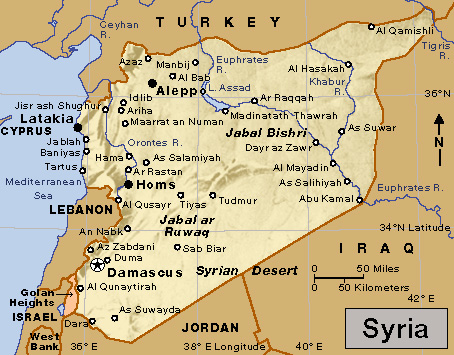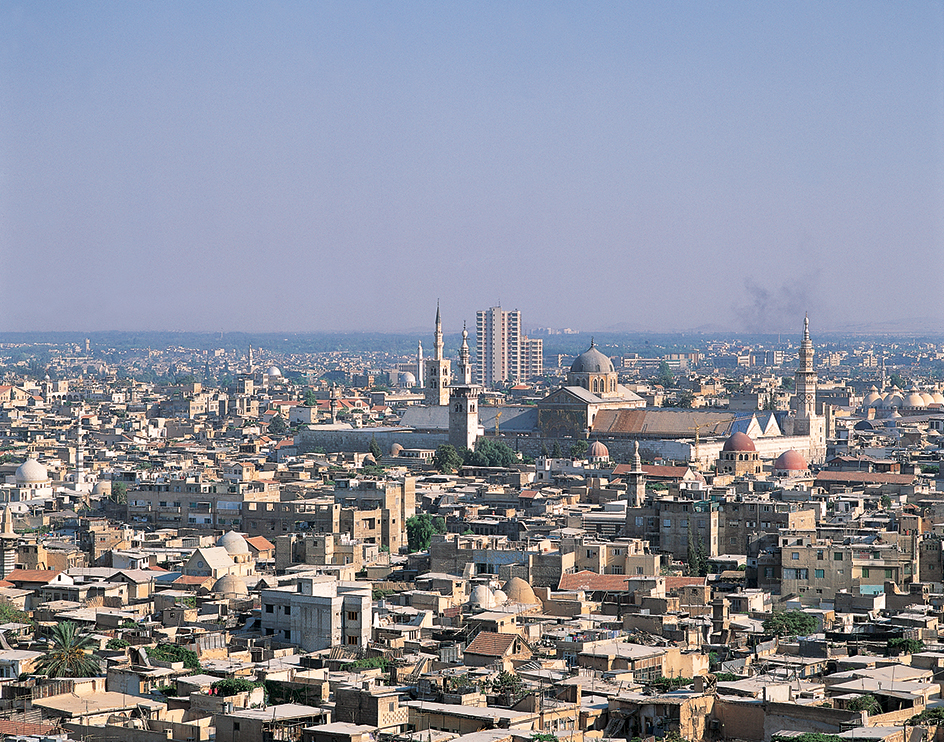Damascus, << duh MAS kuhs >>, is the capital of Syria. It has about 1,700,000 people. Damascus is Syria’s cultural, economic, and political center. It lies in southwest Syria, between the Anti-Lebanon Mountains on the west and the Syrian Desert on the east. The city’s ancient and Arabic name is Dimashq.

The city
is on an oasis in a semiarid plain. The Barada River flows through Damascus and has provided the area with water for thousands of years.
The southern section of Damascus includes an area that is hundreds of years old. There, on narrow, winding streets, merchants sell a wide variety of goods in bazaars called suqs, just as their ancestors did. This area contrasts with the main business district in the northwest, which has many tall buildings erected during the 1900’s. 
Many parts of Damascus and its suburbs have residential areas. Most of the people live in apartments, but some have houses.
Cultural attractions in Damascus include the University of Damascus, the National Library, museums, and theaters. The city has many fine works of Islamic architecture. Among them are the Umayyad, or Great Mosque; the Mosque of Sultan Suleyman; and the tomb of Saladin, a Muslim leader of the 1100’s.
Economy.
Damascus is the chief Syrian center of manufacturing, trade, tourism, and banking and other financial activities. Textile production and food processing are two of the city’s largest industries. Fruit grown in nearby orchards is processed and canned in Damascus. In the old section of the city, craftworkers sell fabrics, metalware, and many other products. Most of the people of Damascus use buses and taxis for local transportation. An international airport lies just outside the city.
History.
Historians believe Damascus may have been founded about 3000 B.C. The city was important during the rule of several early empires, including those of the Assyrians, Greeks, Romans, and Byzantines. The Muslim Arabs captured Damascus from the Byzantines in A.D. 635. Under the leadership of the Umayyad dynasty, the Muslim Arabs made Damascus the capital of their vast empire in 661. But the Umayyads lost control of Damascus during the 700’s, and the city went through a long period of anarchy and decline.
In 1154, the Syrian leader Nur al-Din made Damascus the capital. Saladin, the Muslim ruler of Egypt, took control of Damascus in the late 1100’s. The city became a center of trade. Most of its main historical monuments date from the late 1100’s and the 1200’s.
In 1516, the Ottoman Empire conquered Damascus. The city thrived as trade increased with neighboring countries and with European nations. The Ottomans controlled the region until World War I (1914-1918). Combined Allied and Arab forces captured Damascus during the war. France took control of Syria in 1920.
Syria became independent in 1946, with Damascus as its capital. The city grew rapidly, and new suburbs developed to handle the increase in population. In 2011, violence erupted in Syria. A bloody civil war between government and opposition forces has damaged parts of Damascus. In addition, hundreds of thousands of Syrians displaced from their homes by the war have flocked to Damascus. Their numbers have overwhelmed the city’s housing, medical, and education facilities.
See also Khalid ibn al-Walid.
